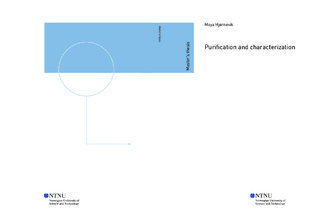| dc.description.abstract | Alginates are a family of linear polysaccharides composed of 1,4-linked β-D-mannuronic acid (M) and α-L-guluronic acid (G) monomer units. The two sugar molecules can only be distinguished by an opposite stereochemical configuration around the fifth carbon, making them C5-epimers. While commercial alginate is extracted exclusively from brown algae Phaeophyceae, it has also been recognized as a calcium binding component in the cell wall of red algae Rhodophyta and as an extracellular polysaccharide produced by bacteria of the genera Azotobacter and Pseudomonas.
Initially, alginate is synthesized as long chains of M-residues only (poly-M), before mannuronan C5-epimerases convert some of the M-residues into G-residues. The relative G-content and how these residues are distributed along the polymer chain give rise to the physical properties of the final alginate. The biopolymer has versatile uses in many industries due to its ability to form thermostable gels in the presence of divalent cations, high water retaining capacity and biocompability.
A family of seven secreted calcium dependent mannuronan C5-epimerases (AlgE1-E7) has been identified in Azotobacter vinelandii. These can be used to enzymatically tailor alginates of specific attributes in vitro. A better understanding of the enzymes substrate binding mechanism allows for a more precisely controlled reaction. This may be attained through studies of the molecular interaction between the alginate modifying enzymes and their substrates.
The present work aims to assess the effect of positively charged amino acids in the substrate binding site of the smallest A. vinelandii mannuronan C5-epimerase AlgE4. The residues selected for site-directed mutagenesis and the associated PCR-primers were designed based on previous work carried out by researchers at NTNU and SINTEF. Protein production was performed using Escherichia coli as expression host, followed by affinity purification. The monomer composition of the epimerase reaction product was determined by 1H-nuclear magnetic resonance (NMR) spectroscopy analyses of end-point epimerized poly-M substrate. The initial activity was estimated using a UV absorbance assay. As anticipated, it was found that neither the wild-type AlgE4 nor any of the mutants created were able to introduce consecutive G-monomers (G-blocks) to the substrate chain. The overall results suggest that arginine residues are more important for the enzyme activity than lysine residues, but that the positive residues as a whole most likely play a role in substrate binding. One of the mutants (R90A) turned out to be virtually inactive -- although a minor initial activity was detected, the relative frequency of G-monomers FG = 0 in the end-point epimerized sample. Surprisingly, characterization of the enzyme-substrate interactions by isothermal titration calorimetry (ITC) revealed that all of the mutants exhibit a higher affinity for heptamer mannuronan (M7) than what was displayed by the wild-type. Furthermore, the ITC data report dissociation constants Kd in the range 76.6-259.0 ± 6.9 nM. In addition, the appurtenant thermodynamic parameters describe a spontaneous reaction with enthalpy being the underlying driving force behind the mechanism, which is to be expected when a substrate is bound in multiple binding subsites, i.e. fewer degrees of freedom.
In conclusion, of the enzymes examined, wild-type AlgE4 was the most active and gave the highest FG, despite having the lowest substrate affinity. The loss of function in R90A is thought to arise from structural malfunction, rather than an actual inactivation of the catalytic mechanism, as the residue in previous literature has been proposed to be part of a polymer-guiding “clamp” presumably crucial for epimerization. Regarding the other mutants, FG and Kd seem to increase with increasing distance for mutations left of the putative active site (K84A, K117A) and decrease with distance to the right (R226A, R249A). A potential explanation for this phenomenon might be that short chain lengths permit the substrate to slide in the cleft and bind in several positions, whereas the mutations restrict the number of possible interactions. However, exactly how these results fit into the established theory or should be dismissed as sheer coincidence remains unclear. This may be further elucidated by conducting ITC experiments using substrates of different chain lengths. Moreover, as ITC is a sensitive method, intentional inactivation of the catalytic residues could perhaps provide more accurate information on the energy of the binding event. | |
